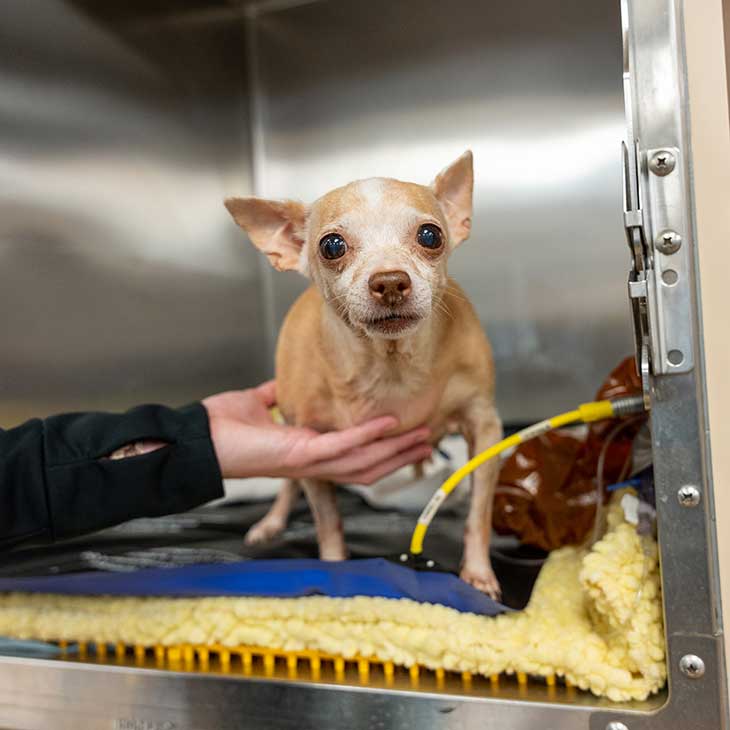
Chihuahua case illustrates importance of spaying your pets
Thursday, September 19, 2024
Media Contact: Kinsey Reed | Communications Specialist | 405-744-6740 | kinsey.reed@okstate.edu
Sally, a 9-year-old chihuahua, came to the Oklahoma State University Veterinary Medical Teaching Hospital after continuous vomiting, diarrhea and an acute distended abdomen.
The emergency critical care team assessed the issue in hopes of finding a solution to cure Sally.
“Whenever we have a patient intact, with a recent history of heat, painful and distended abdomen, we should have pyometra as one possible diagnostic,” said Dr. Franciele Panato Back, small animal emergency medicine clinical assistant professor. “On Sally’s case, she also had a history of eating chicken with possible bones, so foreign body was also a possibility.”
Sally’s physical exam also showed signs of mild to moderate dehydration, severe dental disease and a heart murmur. After a point-of-care ultrasound was completed, veterinarians found Sally had an empty stomach and a fluid-filled uterus. Although these symptoms can mean a number of outcomes, the veterinary team suspected pyometra, which is an infected/pus-filled uterus, and requires surgery.
“Pyometra is usually diagnosed by the presence of abnormal vaginal discharge, which was not present in Sally’s case, an enlarged uterus on radiographs or ultrasound, and bloodwork abnormalities,” said Dr. Melissa Raymond, small animal primary care clinical assistant professor. “Vomiting and diarrhea are also common in dogs with pyometra.”
The team developed a plan with the client to perform bloodwork, radiographs and administer intravenous fluids. They also discussed with the client that pyometra was the most likely diagnosis. After options were presented to the client, it was decided to continue with the procedures at OSU VMTH.
“There are different types of pyometra: closed and open. If the cervix is open, pus can flow out and the uterus is at a lower risk of rupturing,” Raymond said. “In closed pyometras like Sally’s, the cervix is closed, and the pus can build and build until the uterus ruptures inside the abdomen.”
Sally’s bloodwork showed she was suffering from sepsis, a severe infection. Her blood tests showed slight imbalances in her electrolytes, probably from vomiting, and her lactate levels were higher than normal, suggesting some mild to moderate problems with her organs.
“Dogs with pyometras are often septic which increases the risk associated with undergoing anesthesia,” Raymond said. “An infected uterus is at risk of rupturing which would allow all that bacteria and pus to free into the abdomen. Another risk with this type of surgery can be hemorrhages.”
On May 13, Sally underwent surgery to remove her uterus.
“Our anesthesia team did an amazing job minimizing Sally’s anesthetic risk,” Raymond said. “They tailored their drug protocols to prevent Sally from having low blood pressure during the procedure.”
The anesthesia team inserted an arterial line to enable closer monitoring of her blood pressure. Warming devices were utilized during her procedure to prevent her body temperature from plummeting, which is common during abdominal procedures.
“We handled Sally’s tissues with very gentle handling techniques to prevent her uterus from rupturing, and double and triple checked all of our ligatures to make sure Sally did not experience any hemorrhaging,” Raymond said.
Sally’s response to anesthesia was impressive, especially given her health status, showcasing the knowledge and expertise of the OSU VMTH anesthesia team.
After her surgery, Sally did well throughout the night, receiving attentive care from our ICU team. Her condition was closely monitored, and she responded positively to the treatments and medications provided.
Sally's case highlights the potential dangers and complications that can arise from not spaying your female pets. Pyometras are almost always fatal if left untreated Raymond said.
Pyometras can only be prevented by spaying female pets. They can affect both dogs and cats. Each heat cycle increases the pet's risk of developing a pyometra.
“Emergency surgery is often the only treatment, especially for closed pyometras like Sally’s,” Raymond said.
Sally continued to get better and was sent home. Her incision stayed infection-free, and cold compresses helped with the swelling. Although she had a reduced appetite at first, she eventually started eating well again, allowing the discontinuation of antibiotics. She is now eating well and is steadily improving.
“This case was a great example of teamwork and communication coming together for the betterment of our patients,” Raymond said. “My students probably get tired of me saying it, but ‘teamwork makes the dream work,’ and that definitely held true when saving Sally’s life.”
Due to Sally’s condition, Raymond and her team weren’t sure if Sally would survive surgery.
“When I placed the last suture and she was still doing great, I was very much relieved, but also knew her journey back to health wasn’t over yet,” Raymond said. “When Sally got to go home, that’s when I finally let myself celebrate the win that was saving her life.”
